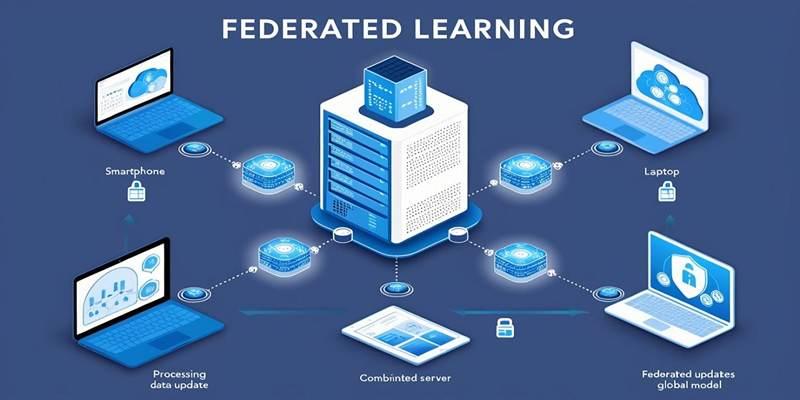Data protection is one of the main issues that people are worried about as artificial intelligence (AI) grows very quickly. In the past, AI models needed a lot of data to work well, and a lot of that data was private or secret, like personal information or business data. It creates big privacy problems, especially when information is kept or sent between computers.
Federated learning is a revolutionary way to solve problems. It lets AI models be taught without sharing raw data, which protects privacy and security. This post will talk about how federated learning works, what its benefits are, and why it's changing the way AI is developed in a world that cares about privacy.
What is Federated Learning?
You can train AI models directly on decentralized devices (like smartphones, computers, or Internet of Things (IoT) devices) instead of on centralized platforms using federated learning. It implies that private information stays on the original device and is only shared with a central computer for collection, along with changes made to the model.
To put it simply, in federated learning, the data stays private, and only the insights gained from the data are shared to improve the model. For instance, when an AI model is trained on smartphones, the data generated from user interactions (such as app usage patterns or location data) doesn’t leave the device. Instead, the model on each phone is updated individually, and only the model updates are sent to the central server, keeping personal data secure.
How Does Federated Learning Work?

In standard machine learning models, raw data from many people or devices is sent to a central computer to be processed and trained on the model. It is turned upside down by federated learning. Here’s a step-by-step process to look at how it works:
- Local Model Training: The AI model is first initialized and then sent out to a decentralized network of devices. Each device (whether it’s a smartphone, computer, or IoT device) uses its local data to train the model.
- Model Updates, Not Data: Instead of sending raw data back to the central server, each device only sends updates to the model (like model parameters or weights) that reflect what it has learned from its local data.
- Aggregation on the Server: The central server aggregates the updates from all devices, combining them into one global model. This aggregated model is then shared back to the devices for further training, and the cycle continues.
- No Data Movement: The key innovation here is that the raw data never moves from its original location. Only the model parameters are shared, ensuring that sensitive data remains secure.
Advantages of Federated Learning:
- Privacy Preservation One of the most significant benefits of federated learning is that it ensures privacy. Since raw data is never shared or uploaded to central servers, the privacy of users and organizations is preserved. It is especially crucial in fields like healthcare, Finance, and social media, where the data being processed can be highly sensitive.
- Compliance with Regulations With global data protection regulations like GDPR and HIPAA, federated learning enables organizations to stay compliant by ensuring that data does not leave its local environment. It greatly reduces the risk of violating privacy laws.
- Reduced Bandwidth and Storage Costs Federated learning minimizes the need for large-scale data transfer, saving bandwidth and storage costs. Rather than moving massive datasets across networks, only small model updates are sent back to the server. It makes it a more cost-effective and efficient way to train AI.
- Personalization Without Data Sharing Federated learning allows AI models to be tailored to individual users without requiring them to share personal data. For example, a smartphone app could learn to predict a user’s preferences and behavior without ever needing to send that data to the cloud. The result is a personalized experience that doesn’t compromise privacy.
Use Cases of Federated Learning:

- Healthcare Federated learning is highly beneficial in healthcare, where strict privacy laws protect patient data. Hospitals and research institutions can collaboratively train AI models to predict diseases, analyze medical images, or even personalize treatment plans, all while keeping patient data private and local.
For example, imagine several hospitals training an AI model to detect cancer in medical imaging. Instead of sharing patient images, federated learning allows each hospital to train its model and only share updates. The result: better AI without compromising patient confidentiality.
- Smartphones and Personal Devices One of the most well-known applications of federated learning is in smartphones. Google’s Gboard, for example, uses federated learning to improve text prediction. The keyboard learns from your typing patterns, predicting the next word based on how you type, but your actual typing data is never shared. Instead, only model updates are exchanged, allowing the system to learn and improve while respecting user privacy.
Challenges of Federated Learning:
- Device Diversity: One challenge is the diversity of devices involved in federated learning. Different devices have varying computational power, which can impact how efficiently they can train models. While powerful devices like servers can handle large-scale training, mobile devices might be slower or have limited resources, making the process less efficient.
- Model Accuracy and Convergence: Federated learning can sometimes result in slower model convergence or less accurate models. Since the data on each device is not identical, local models may diverge, leading to inconsistencies. Careful strategies are needed to ensure that the global model remains effective and accurate.
Conclusion:
Federated learning is a groundbreaking approach that enables the training of AI models without the need for data to leave its local environment. By keeping raw data private and only sharing model updates, it offers a secure, privacy-preserving solution that can be used in numerous industries, from healthcare to Finance. While challenges like device heterogeneity and communication overhead remain, federated learning holds significant promise for the future of AI.
